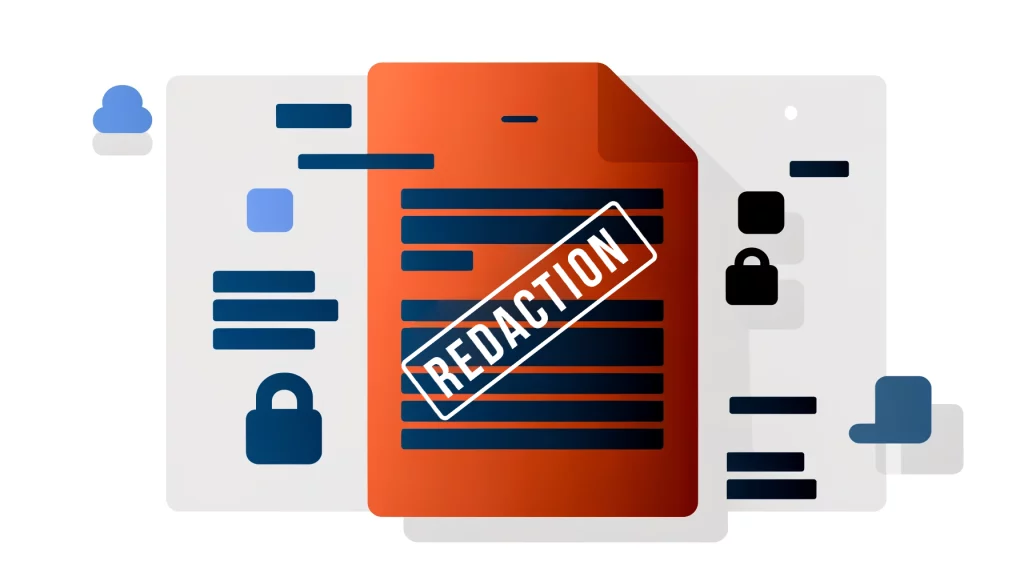
Data Redaction: Protecting Sensitive Information and Ensuring Privacy

Data redaction is a critical process for safeguarding sensitive information in today’s world. It involves removing or obscuring specific portions of a dataset to prevent unauthorized access or exposure.
People commonly use this method to protect personal information, financial details, legal papers, and other sensitive information. This information could be at risk if not safeguarded.
The primary objective is to enable sharing or publishing a dataset without revealing private information. For instance, researchers may require a healthcare provider to share patient records for a study.
Healthcare professionals can share medical information safely by removing names, addresses, and other identifying details. This helps protect patient privacy and ensures compliance with regulations such as HIPAA.
Data Redaction vs. Other Data Protection Methods
While it is a potent tool in the protection arsenal, data redaction is not the only technique available. Other related approaches include data masking, encryption, and access controls.
Knowing the strengths and uses of each method, like data redaction, is important. This will help you choose the right solution. Understanding the benefits of data redaction is crucial. Make sure to consider all options before making a decision.
Once you edit information, you permanently delete it and cannot recover it. In contrast, the correct key can access encrypted data.
Data masking replaces the original sensitive information with fictitious but realistic information, preserving the structure and format of the data. Tokenizing substitutes sensitive info with randomly generated placeholders or tokens.
Data redaction is useful for removing some sensitive data while keeping the rest readable. Preparing resources for public release or sharing with third parties is particularly useful.
Encryption, masking, and tokenizing better protect information when sending or storing it. They are also useful for creating clean test datasets.
Data Redaction Techniques
Several techniques are available for performing data redaction, each with its own merits and applications. One straightforward approach is to completely remove the sensitive data, such as deleting the contents of a “Name” field.
Another common technique is blacking out or obscuring sensitive text or image regions with a solid shape or color. Pixelation is a popular method for hiding sensitive information in images or videos while keeping the main idea intact.
To protect text data, you can replace sensitive information with random characters, placeholders, or fake data. This fake data will resemble the original information.
The redaction technique must match the type of used data. It should also align with the intended purpose of the data. Additionally, it must comply with any relevant regulations or standards.
Benefits of Data Redaction
Implementing a robust data redaction strategy offers several compelling benefits for organizations. It ensures that we follow data privacy rules. It enhances the usefulness and value of assets and serves as a crucial defense against leaks and breaches.
Additionally, editing is simpler to use and check compared to other ways of protecting information.
When to Use Data Redaction
A go-to solution for protecting sensitive information before sharing resources with external parties.
People frequently use redacting for different reasons. One common use is publishing open datasets for research or public benefit. Another use is providing documents for legal discovery. Additionally, companies use redacting to share customer data with third-party service providers.
Other scenarios involve releasing historical records while protecting privacy and declassifying confidential government documents.
To edit properly, it’s important to protect sensitive information while still keeping the data useful.
Organizations must decide which information to remove to comply with laws and ethics. They also need to ensure that they can still use their resources for their intended purpose.
Data Redaction Best Practices
To ensure effective and consistent data redaction, organizations should adhere to a set of best practices.
Organizations are to thoroughly inventory and classify their data assets, understand relevant regulations and standards, and use automation tools to minimize human error.
They must use redaction techniques and formatting consistently. They must document the process and reasons for redacting and enforce strict access controls for both unredacted data and redaction tools.
Challenges and Considerations
While redacting is powerful, it is not without its challenges and considerations. Consistently identifying and removing sensitive information from large and complex datasets poses a major challenge.
To achieve this goal, it is important to have strong data discovery and other processes. Create clear policies and guidelines to determine which information to edit.
Another challenge is finding the right balance between removing sensitive information and keeping the data useful and accurate.” Over-use can render a resource less useful or even misleading, while under-use leaves sensitive information exposed.
Organizations must carefully consider the context and intended use of the data when making redacting decisions.
Potential legal and ethical considerations around redaction also exist. In legal or journalism situations, people may view removing information as an attempt to hide important facts.
Organizations must be transparent about their practices and be prepared to justify their decisions if challenged.
Emerging Trends and Technologies
As data volumes continue to grow and privacy regulations evolve, the field of data redaction is also advancing. A huge trend is the increasing use of artificial intelligence and machine learning to automatically find sensitive information.
These technologies can help organizations scale their redaction efforts and reduce the risk of human error.
Another new area is using homomorphic encryption and other technologies that protect privacy. These technologies let us do calculations on encrypted information without having to remove any parts of it.
Even though they are still new, these methods could change how we protect important information in the future.
The Future of Data Redaction
The importance of effective data redaction will only increase as data grows in volume and complexity.
New technologies like machine learning and natural language processing can help find and delete sensitive information from datasets.
In the future, we will see more advancements in redaction methods and technologies. There will also be a greater focus on standardizing and following best practices.
Companies that focus on data governance and privacy will be more prepared to follow regulations and ethical standards. This will also help them make the most of their assets.
Conclusion
Data redaction is a vital tool for safely sharing and utilizing sensitive information while upholding privacy and security.
The data economy is growing. Organizations skilled at editing information can use data efficiently. They can also honor individuals’ rights and expectations.
Effective redaction requires a strategic, disciplined approach that encompasses best practices, advanced technologies, and a commitment to continuous improvement.
Organizations can gain trust from stakeholders by staying informed about trends and technologies. This will help them fully utilize data in a technology-driven world. Additionally, promoting a culture of privacy and security is essential for building trust and maximizing the benefits of data.
